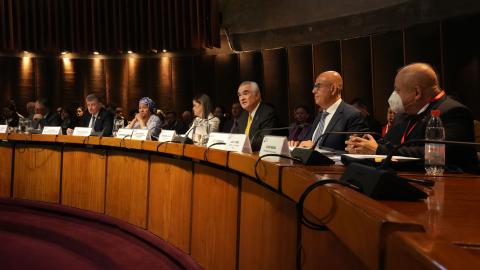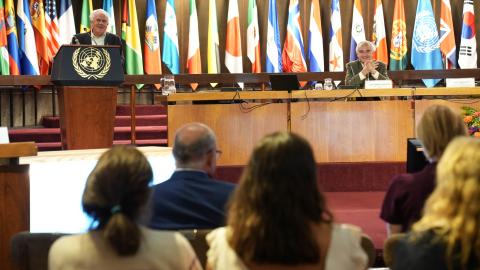Speech
(22 September 2014) About 45 million indigenous people live in Latin America, representing 8.3 % of the region's population. In the last decade, there has been progress on their access to health care and education, their political participation and the recognition of their territorial rights, but significant gaps persist, according to a new report by the Economic Commission for Latin America and the Caribbean (ECLAC).
The document Guaranteeing indigenous people's rights in Latin America: progress in the past decade and remaining challenges, presented today in New York, aims to contribute to the debates that will take place at the World Conference on Indigenous Peoples, on September 22-23, as well as to the process of implementing and following up on the post-2015 development agenda.
The report shows important progress in access to health care, reflected in improvements to indicators such as the proportion of births attended by health professionals or infant mortality among indigenous peoples. The deaths of children under five years old decreased between 2000 and 2010 in seven countries with available data (Costa Rica, Mexico, Brazil, Venezuela, Ecuador, Panama, Guatemala, Peru and Bolivia).
In addition, in seventeen countries there are institutions with specific mandate to address the issue of intercultural health.
In the educational field, class attendance rates have risen significantly at all levels. In the eight countries with data available from the censuses taken in 2010 and 2011, attendance of children between 6 and 11 years of age ranged from 82% to 99%.
Nevertheless important gaps persist vis-à-vis the non-indigenous population in terms of finishing secondary school and gaining access to higher education.
There has been progress as well in the recognition of indigenous peoples' territorial rights, including the right to collective property ownership.
The study shows that improvements have been made in most countries in the region, mainly in demarcating and granting titles to land, but significant challenges remain in terms of territorial control, including natural resources. Between 2010 and 2013, researchers identified more than 200 conflicts in indigenous territories linked to extractive energy and mining activities.
The report highlights the increase of the political participation of indigenous peoples, the continuous strengthening of their organizations and the establishment of alliances for political influence, but warns that these groups are still scarcely represented in State bodies.
Even though progress have been observed on the right of prior, free and informed consent and the respect for institutions and systems of self-government, these achievements are insufficient regarding international standards that recognize the fundamental right to self-determination of these peoples.
The study notes that, according to census data, the estimated indigenous population in Latin America in 2010 was about 45 million people, with 17 million living in Mexico and another 7 million in Peru. The countries with the greatest proportion of indigenous people are Bolivia (62.2 %), Guatemala (41 %), Peru (24,0 %) and Mexico (15.1 %).
Present calculations indicate that Latin America is home to 826 indigenous groups. This represents an increase from the last figure given by ECLAC in 2006, when 642 peoples were identified. This jump is due to the improvements in statistical data in recent years and to indigenous peoples' influence through the struggles for the recognition of their rights.
Brazil has the greatest number of indigenous peoples (305), followed by Colombia (102), Peru (85), Mexico (78) and Bolivia (39). Many of those groups are in danger of disappearing physically or culturally, as was confirmed in the cases of Brazil (70 peoples at risk), Colombia (35) and Bolivia (13).
In addition, the report estimates that another 200 indigenous peoples live in voluntary isolation in Bolivia, Brazil, Colombia, Ecuador, Paraguay, Peru and Venezuela.
The indigenous population's potential for growth is greater than that of non-indigenous people, because their age structure is younger and their fertility rates are higher, although there has been a reduction in this indicator in the five countries with available data (Brazil, Ecuador, Mexico, Panama and Venezuela).
The document also reveals that recent internal migration rates are lower among indigenous peoples than non-indigenous groups and that in 4 of the 10 countries with available information (Mexico, Peru, Uruguay and Venezuela) most indigenous people live in cities.
ECLAC's report analyzes in depth all the available information in each of these areas, advocates to strengthen mechanisms for the protection of indigenous peoples implemented at the United Nations system and offers recommendations to countries encouraging them to recognize indigenous peoples' contribution to build a new development paradigm, based on a structural change towards equality and sustainability.
More information:
In New York please contact María Amparo Lasso, Chief of the ECLAC Public Information Unit. E-mail: mariaamparo.lasso cepal.org; Mobile: (56 9) 7967 8306.
cepal.org; Mobile: (56 9) 7967 8306.


